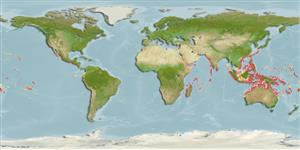Actinopterygii (ray-finned fishes) >
Perciformes (Perch-likes) >
Priacanthidae (Bigeyes or catalufas)
Etymology: Priacanthus: Greek, prion = saw + Greek, akantha = thorn (Ref. 45335). More on author: Bleeker.
Environment / Climate / Range
Ecology
Marine; reef-associated; depth range 15 - 30 m (Ref. 9710), usually 25 - ? m (Ref. 30573). Tropical, preferred ?
Indo-Pacific: Gulf of Aden to Samoa, north to the Philippines and south to the Great Barrier Reef. Often confused with the wide-ranging Priacanthus hamrur. Reports from Taiwan are misidentifications of Priacanthus sagittarius (in Lee, 1980) and Heteropriacanthus cruentatus (in Shen, 1984).
Size / Weight / Age
Maturity: Lm ? range ? - ? cm
Max length : 35.0 cm TL male/unsexed; (Ref. 30573)
Occurs in lagoon and seaward reefs, under ledges or in caves by day (Ref. 9710); often silty habitat (Ref. 48635). Rarely trawled (Ref. 30573). Solitary or in small groups (Ref 90102).
Life cycle and mating behavior
Maturity | Reproduction | Spawning | Eggs | Fecundity | Larvae
Starnes, W.C., 1988. Revision, phylogeny and biogeographic comments on the circumtropical marine percoid fish family Priacanthidae. Bull. Mar. Sci. 43(2):117-203. (Ref. 5403)
IUCN Red List Status (Ref. 115185)
CITES (Ref. 94142)
Not Evaluated
Threat to humans
Harmless
Human uses
Aquarium: commercial
More information
Common namesSynonymsMetabolismPredatorsEcotoxicologyReproductionMaturitySpawningFecundityEggsEgg development
ReferencesAquacultureAquaculture profileStrainsGeneticsAllele frequenciesHeritabilityDiseasesProcessingMass conversion
Tools
Special reports
Download XML
Internet sources
Estimates of some properties based on models
Phylogenetic diversity index (Ref.
82805): PD
50 = 0.5002 [Uniqueness, from 0.5 = low to 2.0 = high].
Bayesian length-weight: a=0.02818 (0.01375 - 0.05776), b=2.91 (2.73 - 3.09), in cm Total Length, based on LWR estimates for this species & (Sub)family-body (Ref.
93245).
Trophic Level (Ref.
69278): 4.1 ±0.6 se; Based on size and trophs of closest relatives
Resilience (Ref.
69278): High, minimum population doubling time less than 15 months (Preliminary K or Fecundity.).
Vulnerability (Ref.
59153): Low vulnerability (23 of 100) .
